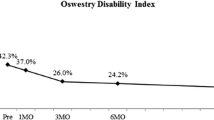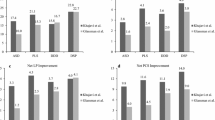Abstract
Purpose
Our aim was to evaluate mid- and long-term results in a cohort of patients who underwent minimally invasive transaxial lumbosacral fixation and to identify clinical and other parameters that can aid in proper patient selection.
Methods
Over a period of ten years, we assessed 164 patients who had a complete follow-up of a minimum of one year (average 54 months). On follow-up, we recorded clinical status, fusion status, visual analogue scale (VAS), Oswestry Lower Back Pain Disability Index (ODI) scores and patient satisfaction.
Results
There were no intra- or peri-operative complications. Overall clinical success rate was 73.8 %. Only sex (female), working status (still working), body mass index (BMI) (lower) and presence of Modic II changes (absent) were correlated with a good result.
Conclusions
Transaxial fixation is a safe, minimally invasive technique that can offer good results in patients with single-level degenerative disc disease (DDD) at the lumbosacral level, with minimal operative risk.



Similar content being viewed by others
References
Zeilstra DJ, Miller LE, Block JE (2013) Axial lumbar interbody fusion: a 6-year single-centre experience. Clin Interv Aging 8:1063–1069. doi:10.2147/CIA.S49802
Cragg A, Carl A, Casteneda F et al (2004) New percutaneous access method for minimally invasive anterior lumbosacral surgery. J Spinal Disord Tech 17:21–28
Patil SS, Lindley EM, Patel VV, Burger EL (2010) Clinical and radiological outcomes of axial lumbar interbody fusion. Orthopedics 33:883. doi:10.3928/01477447-20101021-05
Tobler WD, Gerszten PC, Bradley WD et al (2011) Minimally invasive axial presacral L5-S1 interbody fusion: two-year clinical and radiographic outcomes. Spine 36:E1296–E1301. doi:10.1097/BRS.0b013e31821b3e37
Modic MT, Steinberg PM, Ross JS et al (1988) Degenerative disk disease: assessment of changes in vertebral body marrow with MR imaging. Radiology 166:193–199. doi:10.1148/radiology.166.1.3336678
Marotta N, Cosar M, Pimenta L, Khoo LT (2006) A novel minimally invasive presacral approach and instrumentation technique for anterior L5-S1 intervertebral discectomy and fusion: technical description and case presentations. Neurosurg Focus 20, E9
Tan GH, Goss BG, Thorpe PJ, Williams RP (2007) CT-based classification of long spinal allograft fusion. Eur Spine J Off Publ Eur Spine Soc Eur Spinal Deform Soc Eur Sect Cerv Spine Res Soc 16:1875–1881. doi:10.1007/s00586-007-0376-0
Bohinski RJ, Jain VV, Tobler WD (2010) Presacral retroperitoneal approach to axial lumbar interbody fusion: a new, minimally invasive technique at L5-S1: Clinical outcomes, complications, and fusion rates in 50 patients at 1-year follow-up. SAS J 4:54–62. doi:10.1016/j.esas.2010.03.003
Lindley EM, McCullough MA, Burger EL et al (2011) Complications of axial lumbar interbody fusion. J Neurosurg Spine 15:273–279. doi:10.3171/2011.3.SPINE10373
Montesano PX, Magerl F, Jacobs RR et al (1988) Translaminar facet joint screws. Orthopedics 11:1393–1397
Jacobs RR, Montesano PX, Jackson RP (1989) Enhancement of lumbar spine fusion by use of translaminar facet joint screws. Spine 14:12–15
Faundez A, Tournier C, Garcia M et al (2016) Bone morphogenetic protein use in spine surgery-complications and outcomes: a systematic review. Int Orthop 40:1309–1319. doi:10.1007/s00264-016-3149-8
Gundanna MI, Miller LE, Block JE (2011) Complications with axial presacral lumbar interbody fusion: A 5-year postmarketing surveillance experience. SAS J 5:90–94. doi:10.1016/j.esas.2011.03.002
Kiely PD, Mount LE, Du JY et al (2016) The incidence and risk factors for post-operative ileus after spinal fusion surgery: a multivariate analysis. Int Orthop 40:1067–1074. doi:10.1007/s00264-016-3148-9
Järvinen J, Karppinen J, Niinimäki J et al (2015) Association between changes in lumbar Modic changes and low back symptoms over a two-year period. BMC Musculoskelet Disord 16:98. doi:10.1186/s12891-015-0540-3
Martínez-Quiñones JV, Aso-Escario J, González-García L et al (2016) Are Modic Changes Able to Help us in Our Clinical Practice? A Study of the Modic Changes in Young Adults During Working Age. Clin Spine Surg. doi:10.1097/BSD.0000000000000195
Laustsen AF, Bech-Azeddine R (2016) Do Modic changes have an impact on clinical outcome in lumbar spine surgery?A systematic literature review. Eur Spine J Off Publ Eur Spine Soc Eur Spinal Deform Soc Eur Sect Cerv Spine Res Soc. doi:10.1007/s00586-016-4609-y
Mok FPS, Samartzis D, Karppinen J et al (2016) Modic changes of the lumbar spine: prevalence, risk factors, and association with disc degeneration and low back pain in a large-scale population-based cohort. Spine J Off J North Am Spine Soc 16:32–41. doi:10.1016/j.spinee.2015.09.060
Mattei TA, Rehman AA, Teles AR et al (2016) The “Lumbar Fusion Outcome Score” (LUFOS): a new practical and surgically oriented grading system for preoperative prediction of surgical outcomes after lumbar spinal fusion in patients with degenerative disc disease and refractory chronic axial low back pain. Neurosurg Rev. doi:10.1007/s10143-016-0751-6
Zhang Y-H, Zhao C-Q, Jiang L-S et al (2008) Modic changes: a systematic review of the literature. Eur Spine J 17:1289–1299. doi:10.1007/s00586-008-0758-y
Alamin TF, Kim MJ, Agarwal V (2011) Provocative lumbar discography versus functional anesthetic discography: a comparison of the results of two different diagnostic techniques in 52 patients with chronic low back pain. Spine J Off J North Am Spine Soc 11:756–765. doi:10.1016/j.spinee.2011.07.021
Cuellar JM, Stauff MP, Herzog RJ et al (2016) Does provocative discography cause clinically important injury to the lumbar intervertebral disc? A 10-year matched cohort study. Spine J Off J North Am Spine Soc 16:273–280. doi:10.1016/j.spinee.2015.06.051
Eck JC, Sharan A, Resnick DK et al (2014) Guideline update for the performance of fusion procedures for degenerative disease of the lumbar spine. Part 6: discography for patient selection. J Neurosurg Spine 21:37–41. doi:10.3171/2014.4.SPINE14269
Margetic P, Pavic R, Stancic MF (2013) Provocative discography screening improves surgical outcome. Wien Klin Wochenschr 125:600–610. doi:10.1007/s00508-013-0404-5
Putzier M, Streitparth F, Hartwig T et al (2013) Can discoblock replace discography for identifying painful degenerated discs? Eur J Radiol 82:1463–1470. doi:10.1016/j.ejrad.2013.03.022
Ohtori S, Kinoshita T, Yamashita M et al (2009) Results of surgery for discogenic low back pain: a randomized study using discography versus discoblock for diagnosis. Spine 34:1345–1348. doi:10.1097/BRS.0b013e3181a401bf
Author information
Authors and Affiliations
Corresponding author
Rights and permissions
About this article
Cite this article
Zeilstra, D.J., Staartjes, V.E. & Schröder, M.L. Minimally invasive transaxial lumbosacral interbody fusion: a ten year single-centre experience. International Orthopaedics (SICOT) 41, 113–119 (2017). https://doi.org/10.1007/s00264-016-3273-5
Received:
Accepted:
Published:
Issue Date:
DOI: https://doi.org/10.1007/s00264-016-3273-5




